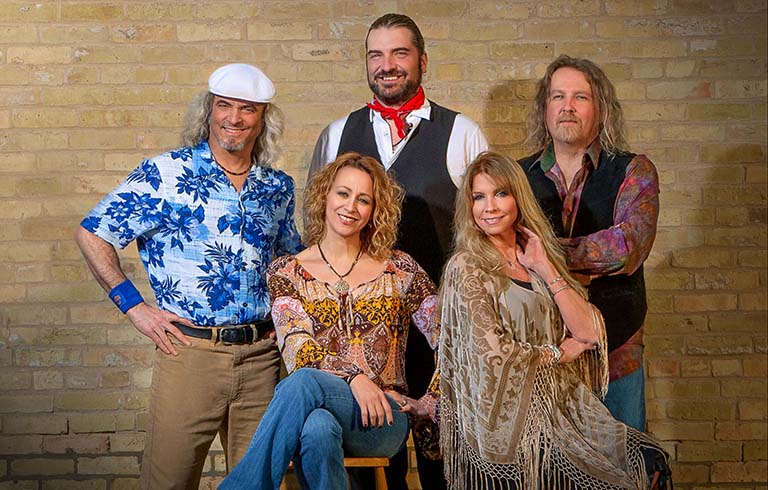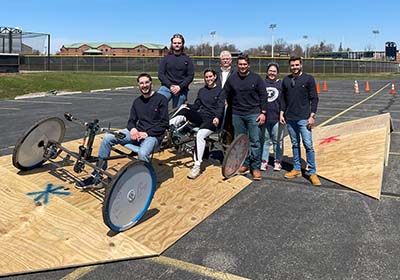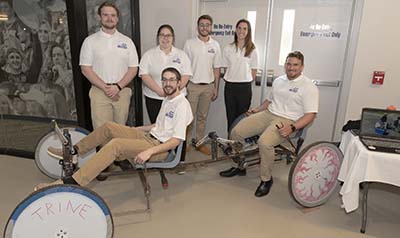
Tusk: Fleetwood Mac tribute coming to Trine Nov. 17
Tusk, the Ultimate Fleetwood Mac Tribute, will bring the band’s greatest hits to the stage of Trine University’s T. Furth Center for Performing Arts on Friday, Nov. 17.
May 04, 2022
HUNTSVILLE, Ala. — Trine University’s NASA Rover team took second place overall in the college and university division of the 2022 NASA Human Exploration Rover Challenge (HERC), the highest finish for Trine in the competition’s history.
Announced virtually on April 29, the finish also marked the third year in the row the university has received a major award in the Challenge.
“This team, like teams from the last couple of years, persevered despite challenges from the global pandemic to complete and compete in the NASA HERC competition,” said Timothy Jenkins, Ph.D., faculty advisor and associate professor in Trine’s Department of Design Engineering Technology. “Their drive and commitment to excellence is demonstrated in the completed vehicle, the 3D-printed tool task challenge and the STEM engagement activities completed this year.”
Team members, all design engineering technology majors, were Ben Alston of Adrian, Michigan; Emma Daniels of Plymouth, Indiana; Tony Greenman of Jasper, Michigan; Steph Hartpence of Elkhart, Indiana; Hunter Klein of Shipshewana, Indiana; and Connor Malmquist of Valparaiso, Indiana.
This year’s design was the lightest a Trine team has entered, with the finished rover weighing 142 pounds. Klein said the team’s biggest accomplishment was the design of the rover’s wheels, which were made from corrugated aluminum, a material normally used for road signs.
“We took material from another process, integrated it into our process and it worked beautifully,” he said.
The team also 3D-printed the rim that surrounds the corrugated aluminum and used a lighter fill material inside.
“Since it’s plastic, it’s very lightweight,” said Hartpence. “You could probably throw that thing like a frisbee.”
“It is totally a new design that we have not yet seen, so we were a little nervous when we first started using it, but it turned out perfectly,” said Klein. “It was able to withstand all the forces we needed it to and hold up during the competition.”
The team began working on the rover in August and carried out the design process throughout the fall. Around the beginning of this year, they finalized their 3D models and started production of the rover.
Since NASA is still working remotely, the competition was not held in person. Instead, the team built a course on the Trine campus for the rover to complete its tasks and sent video to NASA for judging.
Tom Trusty, chair of Trine’s Department of Design Engineering Technology, said he commended Jenkins for “being an excellent student mentor for this project, securing NASA grants for funding each year and steadily guiding each subsequent graduating class to achieve top-level outcomes in an international competition.”
Jenkins said others on campus also contributed to the team’s success.
“The unwavering support of the Design Engineering Technology Department faculty and staff, Mr. Joseph Thompson from mechanical engineering, and the team in Campus Operations that helped the students with course setup and teardown made this all possible for our students,” said Jenkins. “This is truly a Trine thing!”
Trine’s highest previous finish was 17th place overall in 2014. Tecnologico de Monterrey, Xochitepec, Mexico, was the overall winner of this year’s event.
This is the third year in a row Trine’s NASA Rover team has earned a top award at the international competition. Last year, Trine won the Task Challenge Award, presented to the team producing the best 3D-printed tool design.
In 2020, Trine’s team won the AIAA Best Report Award, recognizing the report that best described the team’s technical design process for the Challenge.
The student competition — one of seven Artemis Student Challenges — tasks high school and college teams from around the world to design, build and test a human-powered rover capable of traversing simulated terrain from the Moon, Mars and other rocky planets. Along the way, teams are also required to complete scientific tasks, reflecting spacewalks that were completed during NASA’s Apollo Program and may be completed during NASA’s Artemis Program.
For more than 25 years, the annual NASA Human Exploration Rover Challenge and its sponsors have encouraged student teams from the United States and around the world to push the limits of innovation and imagine what it will take to explore the Moon, Mars and other worlds.
The Human Exploration Rover Challenge is managed by the Office of STEM Engagement at George C. Marshall Space Flight Center in Huntsville, Alabama. The competition reflects the goals of the Artemis program, which seeks to put the first woman and first person of color on the Moon. NASA’s Office of STEM Engagement uses competitions to further the agency’s goal of encouraging students to pursue degrees and careers in the science, technology, engineering and mathematics fields.

